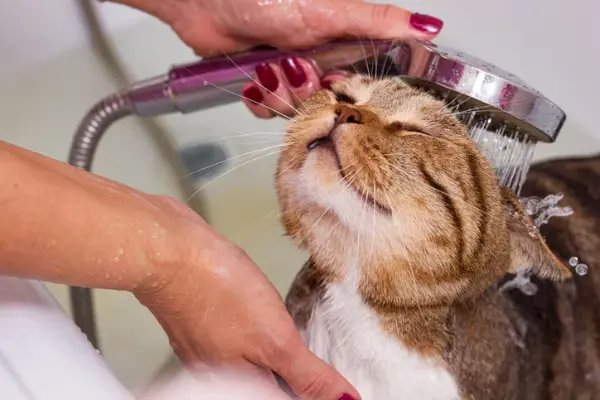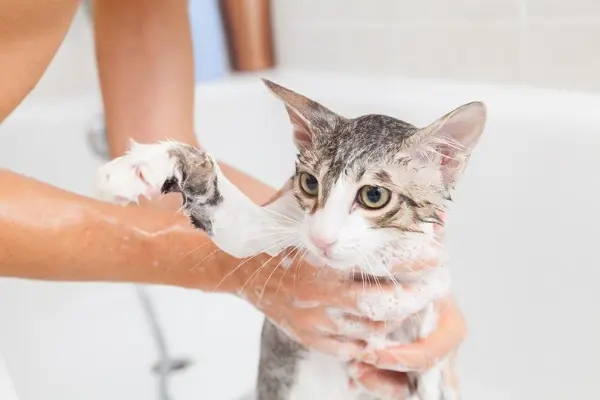How Often To Bathe A Cat? Factors, Benefits, Risks & Tips
Cat owners may ask how often to bathe their pets. After all, cats are meticulous groomers who lick their fur for hours to stay clean. Do they need baths often? Its answer is it depends. Cats may need frequent baths or never be bathed to maintain their skin and fur.
Several factors determine how often you bathe your feline. This blog post will also discuss cat bathing pros and cons and how to do it without harming or upsetting them.

Factors that Determine How Often to Bathe a Cat
How often you bathe your kitty depends on it. Bathing frequency depends on factors like:
Type of coat
Long or thick-furred cats may need more baths. Long or thick fur can trap dirt, oil, and other debris, causing mats, tangles, and skin issues.
If they’re overweight, old, or have arthritis, cats with long or thick fur may have trouble cleaning themselves. Cats with short or thin fur may not need baths unless they get dirty or have a health issue.
Lifestyle
Outdoor cats may need additional baths and outdoor cats are more prone to encounter dust, pollen, muck, insects, and bugs, which can ruin their fur or irritate their skin.
Outdoor cats may fight with other animals, leaving wounds or infections that need cleaning. However, indoor cats may only need bathing if they have pests, allergies, or are overweight.
Good Health
Healthy cats may need fewer baths than sick cats. Bathing cats with skin allergies, eczema, fungal infections, or greasy skin may soothe their skin and remove allergens. To avoid heated or infected urine, cats with diabetes, kidney disease, or urinary tract issues may need baths.
Cats with arthritis, obesity, or paralysis may need baths to be clean and comfortable. If your kitty has a health issue, only bathe it with a vet’s help. Some products or methods may need to be revised.
Preference
Cats can prefer or loathe bathing. This may depend on the cat’s breed, attitude, or history. Fun, curious cats may not mind getting wet or petted. Some breeds, like the Turkish Van and Bengal, may prefer water for natural reasons.
Some cats may have learned that bathing signifies treats or care since childhood. However, shy or scared cats may view bathing as a threat or punishment. Because of their heredity, Persians and Himalayans may dislike water.
Some cats are scared of water and touch after being burned, scratched, or drowned while bathing.
How often to bathe a kitty is still being determined. Talking to your vet is the best approach to determining cat bathing frequency. They can assess your cat’s needs and provide bathing products and plans.

Benefits of Bathing a Cat
Bathing cats can be good or detrimental, depending on the cat and how it’s done. The pros and cons of cat bathing are below:
It can improve the cat’s skin and coat health
A cat bath removes dirt, oil, dead skin cells, and parasites from its fur and skin. This can prevent or treat dandruff, matting, tangling, dryness, irritation, inflammation, and infections. Bathing your cat helps its skin oils reach all portions of its body.
These oils moisturize and protect skin and fur. Bathing can make a cat’s fur softer, smoother, and easier to handle, improving its appearance and feel.
It can reduce the cat’s shedding and odor
Bathing your cat removes excess hair. This reduces hair on furnishings and the house. This may also help the cat consume fewer hairballs, which can clog its digestive tract. Some cats have foul odors that can be eliminated by bathing.
Diabetes, kidney illness, or urinary infections can influence their urine and feces. Bathing a cat helps remove the stench of skunk spray, rubbish, chemicals, and other messes.
It can prevent or treat fleas and other parasites
Fleas and other pests can be deterred or eliminated. Bathing a cat kills or removes fleas, bugs, lice, mites, and worms. Parasites can cause itching, scratching, biting, hair loss, anemia, and disease transfer. This prevents or treats certain symptoms.
Bathing your cat can eliminate flea eggs, larvae, and pupae, preventing their return. Cats need more than baths to get rid of fleas and other parasites. Topical or oral medications, vacuuming, or mattress washing should always follow bathing.
It can reduce the cat’s allergens
Bathing your cat reduces saliva, dander, and pollen production. This can aid cats and their owners with allergies or asthma. Bathing a cat removes allergens, relieving symptoms including sneezing, coughing, breathing, and itching.
Bathing the cat reduces exposure for cat allergy sufferers because fewer allergens are discharged into the air or on furniture or clothes.

Risks of Bathing a Cat
It could stress or injure the cat
A cat may be scared or stressed if it doesn’t like baths. Bathing a cat may make it terrified or anxious, causing it to fight, scratch, bite, or run away. Cats and cat caregivers can get cuts, bruises, sprains, and infections.
Bathing a cat can also damage its mental health by eroding its trust, confidence, and security, affecting its behavior.
It may damage the cat’s fur or oils
Too many baths or improper products can strip your cat’s skin and fur of natural oils, leaving it dry, stiff, or dull. This may cause cat fur and skin damage, irritation, or infection. Bathing a cat with too much or too little water might damage its fur.
This is especially true for poorly dried fur. This can crack, split, or fall out of the cat’s hair, changing its appearance and warmth.
It may hinder cat grooming
Bathing a cat may prevent it from grooming, which is excellent for its mental and physical health. Cats groom themselves to stay clean, maintain body temperature, distribute natural oils, enhance blood flow, kill vermin, and express emotions.
Cats kiss, nuzzle, or rub while grooming to bond with people or other cats. Bathing a cat may disrupt its cleaning regimen, making it feel unpleasant, unhappy, or unsafe.

Tips To Bath a Cat
Sometimes bathing a cat is vital to keep it clean and healthy, but it cannot be easy. How often to bathe a kitty depends on its coat, lifestyle, health, and choice. Bathing a cat has pros and cons depending on how and what you use.
Here are some safe and effective cat bathing tips:
| Sr No | Tips |
|---|---|
| 1 | Before bathing your cat, trim their nails, brush their fur, and choose the correct shampoo. Playing and treating your cat can help them become used to the tub and water. |
| 2 | Choose a sink or tub with a rubber mat or towel to prevent slipping during bathing. Warm the sink or tub to 101–102 degrees Fahrenheit or 38.5 degrees Celsius, the cat’s body temperature. Convenient pet shower sprayer kits with stainless steel hoses are available. |
| 3 | Wet your cat’s fur gently, avoiding the face and ears. Apply a tiny amount of cat-friendly shampoo to the fur and massage from neck to tail. Wash away shampoo residue with clean water. |
| 4 | Lift your cat from the water and wrap them in a warm towel. Dry them without rubbing, which can damage fur. Use a low-setting hair dryer, but make sure your cat isn’t terrified. Until dry, keep your cat comfortable and draft-free. |
| 5 | Give your cat praise, attention, and rewards for being a good sport. To smooth and shine their fur, brush again. |

FAQs
Indoor cats typically do not need frequent baths. The National Cat Groomers Institute suggests a bath once every 4-6 weeks.
Yes, bathing your cat once a month is generally sufficient. However, the frequency may vary based on the cat’s coat type, health, and lifestyle.
Yes, you can bathe your cat at night. Ensure a comfortable environment, use warm water, and follow proper bathing techniques to minimize stress.
Cats may have a mild scent, but it’s usually not strong. Regular grooming and maintaining a clean environment help control any potential odor.
There’s no conclusive evidence that cats sleep more after a bath. The impact on their sleep may vary based on the individual cat’s preferences and experiences.
Conclusion
In conclusion, the cat’s coat type, lifestyle, health, and preferences determine how often to bathe it. Cats are careful groomers, but sometimes they need a bath.
The blog discusses cat bathing frequency and its pros and cons. Bathing helps skin and coat health, reduces shedding and odor, and prevents parasites. However, stress, injury, cat fur, and oil damage must be considered.
The guide emphasizes preparation, product selection, and gentle handling to simplify cat washing. Cat owners may give their pets a good bath by following these tips.
When asked how often to bathe your kitty, visit your vet. They may give your cat personalized grooming tips to keep it healthy and happy.
Related Posts
Why Does My Cat Bite My Nose? Its Reasons And Solutions
Xanthan Gum Safety And Usage For Cats: Its Safety And Efficacy
Can Cats Eat Pomegranate? And Its Potential Health Implications
Natural Remedies For Cats Asthma: Effective Treatment At Home






